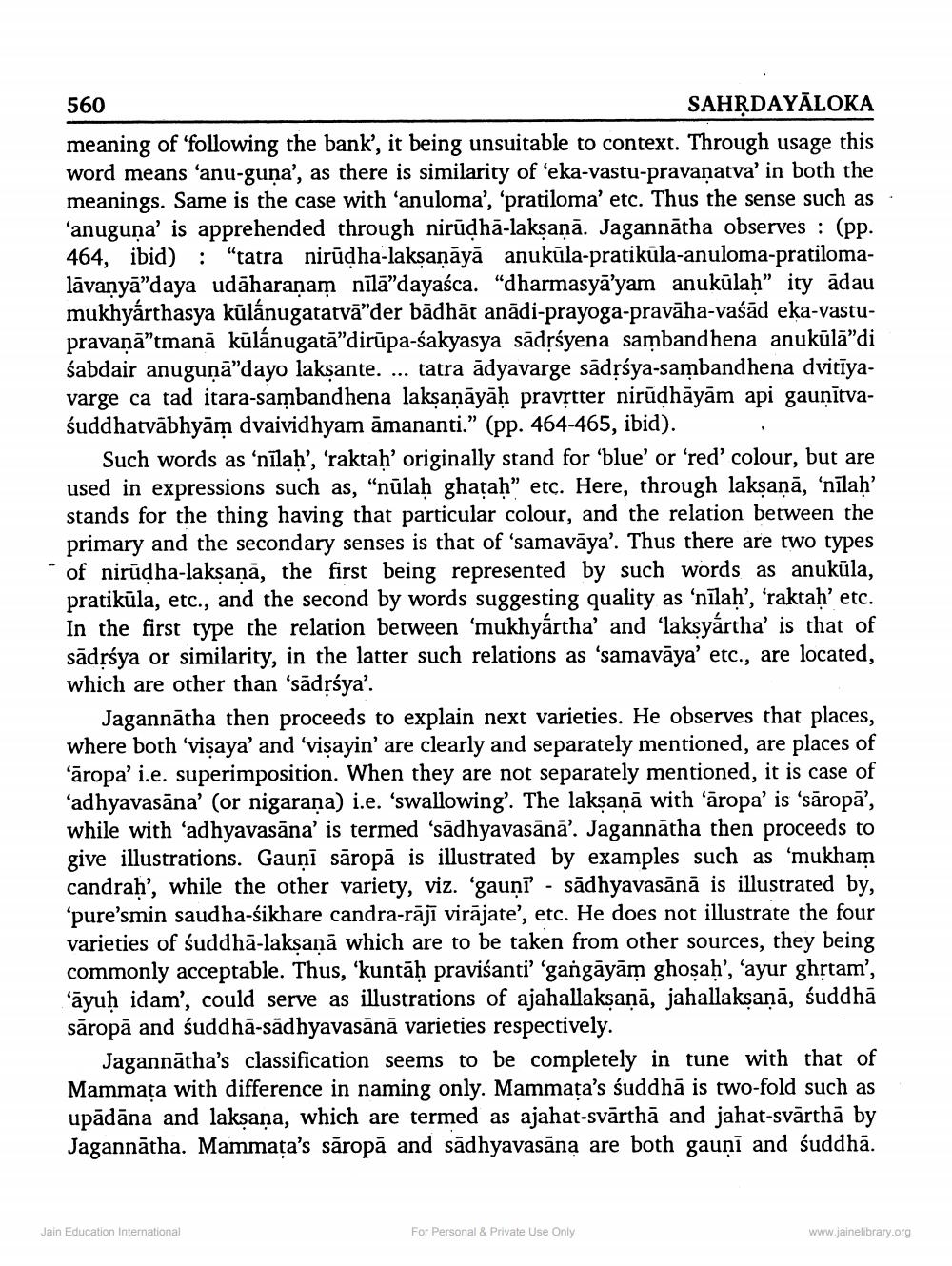________________
560
SAHRDAYĀLOKA meaning of 'following the bank', it being unsuitable to context. Through usage this word means 'anu-guņa', as there is similarity of ‘eka-vastu-pravanatva' in both the meanings. Same is the case with 'anuloma', 'pratiloma' etc. Thus the sense such as 'anuguna' is apprehended through nirudhā-lakṣaṇā. Jagannātha observes : (pp. 464, ibid) : “tatra nirudha-laksanāyā anukūla-pratikūla-anuloma-pratilomalāvanyā”daya udāharanam nīlā”dayaśca. “dharmasyā’yam anukūlah” ity ādau mukhyārthasya kūlānugatatvā"der bādhāt anādi-prayoga-pravāha-vaśād eka-vastupravanā"tmanā külánugatā"dirūpa-sakyasya sadrsyena sambandhena anukūlā"di śabdair anugunā”dayo laksante. ... tatra ādyavarge sādęśya-sambandhena dvitiyavarge ca tad itara-sambandhena laksanāyāḥ pravṛtter nirudhāyām api gauņītvaśuddhatvābhyām dvaividhyam amananti.” (pp. 464-465, ibid).
Such words as ‘nīlah', 'raktah' originally stand for 'blue' or 'red' colour, but are used in expressions such as, “nūlah ghataḥ” etc. Here, through lakṣaṇā, 'nīlah' stands for the thing having that particular colour, and the relation between the primary and the secondary senses is that of 'samavāya'. Thus there are two types of nirudha-laksaņā, the first being represented by such words as anuküla, pratikūla, etc., and the second by words suggesting quality as 'nīlah', 'raktah' etc. In the first type the relation between 'mukhyártha' and 'laksyártha' is that of sādrśya or similarity, in the latter such relations as 'samavāya' etc., are located, which are other than ‘sādṛśya'.
Jagannātha then proceeds to explain next varieties. He observes that places, where both 'visaya' and 'vişayin' are clearly and separately mentioned, are places of 'āropa' i.e. superimposition. When they are not separately mentioned, it is case of ‘adhyavasāna' (or nigarana) i.e. 'swallowing'. The laksaņā with ‘āropa' is 'sāropā', while with 'adhyavasāna' is termed 'sādhyavasānā. Jagannātha then proceeds to give illustrations. Gauni sāropā is illustrated by examples such as ‘mukham candrah', while the other variety, viz. 'gauni - sādhyavasānā is illustrated by, 'pure'smin saudha-śikhare candra-rāji virajate', etc. He does not illustrate the four varieties of suddhā-laksanā which are to be taken from other sources, they being commonly acceptable. Thus, 'kuntāḥ pravišanti 'gangāyām ghosah', 'ayur ghrtam', 'āyuh idam', could serve as illustrations of ajahallaksaņā, jahallaksanā, śuddhā sāropā and suddhā-sādhyavasānā varieties respectively.
Jagannātha's classification seems to be completely in tune with that of Mammata with difference in naming only. Mammata's suddhā is two-fold such as upādāna and lakṣaṇa, which are termed as ajahat-svārthā and jahat-svārthā by Jagannātha. Mammata's sāropā and sadhyavasāna are both gauņi and suddhā.
Jain Education International
For Personal & Private Use Only
www.jainelibrary.org




